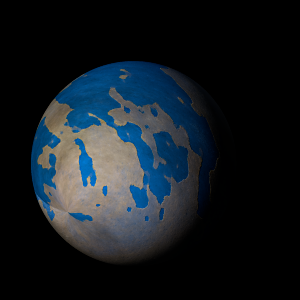|
|
Space Astro
|
Info for exoplanet "Syaog"
| Scientific (actual) data |
|---|
| Planet | K2-256 b |
| Planet status | Confirmed |
| Radius | 0.235 |
| Orbital period | 5.52011 |
| Semi major axis | 0.0578 |
| Discovered | 2018 |
| Updated | 2021-02-05 |
| Tconj | 2457590 |
| Impact parameter | 0.42 |
| Temperature (kelvin) | 845 |
| Publication | Published in a refereed paper |
| Detection type | Primary Transit |
| Alternate names | 2MASS J12245451-0203572 b, EPIC 228968232 b, EPIC 228968232.01, WISE J122454.50-020357.5 b |
| Star name | K2-256 |
| Right ascension | 186.23° |
| Declination | -2.07° |
| Mag j | 13.35 |
| Mag h | 12.912 |
| Star distance | 580.5 |
| Star metallicity | -0.1 |
| Star mass | 0.84 |
| Star radius | 0.78 |
| Star temperature | 5219 |
| Star alternate names | 2MASS J12245451-0203572, EPIC 228968232, WISE J122454.50-020357.5 |
| Wikipedia article | K2-256 b |
Back
| |
| Fictional info (?) |
|---|
| Suggested name | Syaog |
| Planet type | Hot planet |
| In English, Syaog is often referred to as the "green planet" because the ammonium hydrosulfide (NH4SH) prevalent on its surface gives it a dark green appearance that is distinctive among the astronomical bodies visible to the naked eye.
Syaog's atmosphere is similar to Syanzh Ei's in its primary composition of methane and ammonium hydrosulfide (NH4SH), but it contains more "ices" such as water, ammonia, and methane, along with traces of other hydrocarbons. The planet is named after the deity Syaog, the god of love and beauty.
Its orbital eccentricity is the largest of all known planets in its solar system; at perihelion, Syaog's distance from K2-256 is only about two-thirds (or 92 pct) of its distance at aphelion. Having almost no atmosphere to retain heat, it has surface temperatures that vary diurnally more than on any other planet in its solar system, ranging from 95°K (-178°C) at night to 735°K (462°C) during the day across the equatorial regions.
It is radically different from Syanzh Ei in other respects.
As the closest planet to Syanzh Ei, Syaog has been a prime target for early extra solar exploration.
Like a few of the other hot planets, Syaog has a ring system, a magnetosphere, and numerous moons, Oxye being the most famous one. |
| Atmosphere | Methane | 99% |
| Ammonium hydrosulfide (NH4SH) | 0.59% |
| Hydrogen deuteride (HD) | 0.0082% |
| Carbon monoxide | 0.00026% |
| Argon | 0% |
| Atmospheric pressure | 90 bar |
 |
| Moon | Xyong Syuan | Medium-sized almost round rocky moon |
| Yaoh'waich | Large round ice asteroid |
| Oxye | Huge potato shaped rocky moon |
| Chyun | Small irregular rocky moon |
| Yingyiq | Huge round gaseous planetoid |
| Pyun Wan | Huge irregular ice asteroid |
| Araih-wen | Huge slightly egg-shaped crater-filled moon |
| Zyobejyue | Huge slightly egg-shaped ice comet |
| Aoch-wof | Huge almost round crater-filled planetoid |
| Jajouch Ang | Medium-sized potato shaped rocky asteroid |
| Wuqyan Gwai | Medium-sized potato shaped crater-filled asteroid |
| Yuanf | Very small round rocky planetoid |
| Google search for Syaog |
|
Website by Joachim Michaelis
|
|
|
|